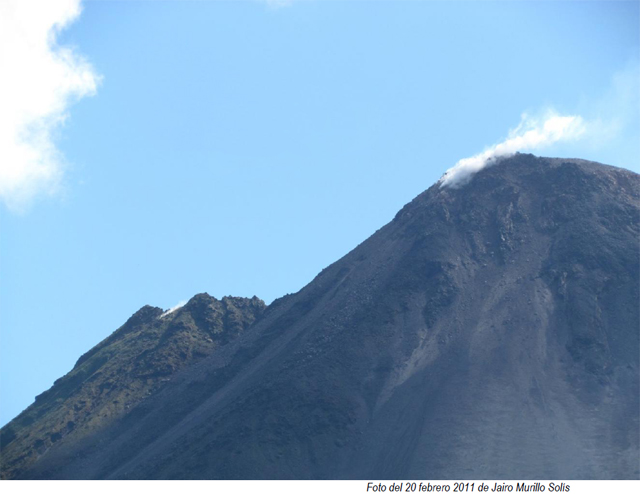Report on Arenal (Costa Rica) — November 2012
Bulletin of the Global Volcanism Network, vol. 37, no. 11 (November 2012)
Managing Editor: Richard Wunderman.
Arenal (Costa Rica) Continued calm with minor gas emissions
Please cite this report as:
Global Volcanism Program, 2012. Report on Arenal (Costa Rica) (Wunderman, R., ed.). Bulletin of the Global Volcanism Network, 37:11. Smithsonian Institution. https://doi.org/10.5479/si.GVP.BGVN201211-345033
Arenal
Costa Rica
10.463°N, 84.703°W; summit elev. 1670 m
All times are local (unless otherwise noted)
Since 1968, Arenal experienced periods of moderate-to-robust volcanic activity that continued through September 2010, when activity declined (BGVN 35:07 and 36:04). This report discusses events between December 2010 and October 2012, a period of continued relative tranquility.
Although sporadic Strombolian explosions were reported in December 2010, they soon ceased; since then, no explosions had occurred through as late as October 2012. According to the Observatorio Vulcanologico Sismologica de Costa Rica-Universidad Nacional (OVSICORI), activity was limited to weak gas emissions, primarily through the NE vent in Crater C and through fumaroles in Crater D (figure 113).
During the reporting period, the pH of rain-water gradually increased near the volcano. According to OVSICORI, the gradual decrease in rainfall acidity was associated with reduced magmatic activity.
According to OVSICORI, 2012 was one of the years of lowest activity for Arenal since 1968. No volcano-tectonic earthquakes, volcanic earthquakes, or tremors were recorded during the year, and no magmatic activity was detected. OVSICORI (citing Muller and others, 2011) reported that the Electronic Distance Measurement (EDM) network on the W flank of Arenal showed some subsidence from 2008 to near the end of 2011, but then the rate of subsidence decreased and no deformation occurred in 2012.
In June 2012, OVSICORI reported that night observations and long-exposure photographs of the summit revealed no incandescence. According to OVSICORI, the lack of incandescence indicated that gas emissions were of low temperature (probably <300°C), allowing water vapor to condense rapidly upon contact with the atmosphere. Hydrothermal activity remained low with only a few diffuse fumaroles rising from the N flank of Crater C (figure 113).
According to OVSICORI, an Mw 7.6 earthquake on 5 September 2012 centered on the Nicoya Peninsula (Costa Rica) caused moderate rock avalanches at Arenal, mainly dislodging unstable blocks on the active crater's N and NW rim. However, no changes were noted either in the hot springs around the volcano or in surficial expressions of volcanism.
A special issue of Journal of Volcanology and Geothermal Research was devoted to Arenal volcano (see Reference subsection below).
References. Marsh, B. (ed.), 2006, Arenal volcano, Costa Rica: Magma genesis and volcanological processes, Journal of Volcanology and Geothermal Research, v. 157, issues 1-3.
Muller, C., del Potro, R., Gottsmann, J., Biggs, J., and Van der Laat, R., 2011, Combined GPS, EDM and triangulation surveys of the rapid down-slope motion of the western flank of Arenal Volcano, Costa Rica, American Geophysical Union, Fall Meeting 2011, abstract ## V53C-2639 (Poster).
Geological Summary. Conical Volcán Arenal is the youngest stratovolcano in Costa Rica and one of its most active. The 1670-m-high andesitic volcano towers above the eastern shores of Lake Arenal, which has been enlarged by a hydroelectric project. Arenal lies along a volcanic chain that has migrated to the NW from the late-Pleistocene Los Perdidos lava domes through the Pleistocene-to-Holocene Chato volcano, which contains a 500-m-wide, lake-filled summit crater. The earliest known eruptions of Arenal took place about 7000 years ago, and it was active concurrently with Cerro Chato until the activity of Chato ended about 3500 years ago. Growth of Arenal has been characterized by periodic major explosive eruptions at several-hundred-year intervals and periods of lava effusion that armor the cone. An eruptive period that began with a major explosive eruption in 1968 ended in December 2010; continuous explosive activity accompanied by slow lava effusion and the occasional emission of pyroclastic flows characterized the eruption from vents at the summit and on the upper western flank.
Information Contacts: Observatorio Vulcanologico Sismologica de Costa Rica-Universidad Nacional (OVSICORI-UNA), Apartado 86-3000, Heredia, Costa Rica (URL: http://www.ovsicori.una.ac.cr/); CostaRica21 (URL: http://www.costarica21.com/).


